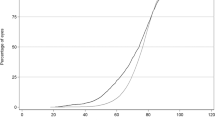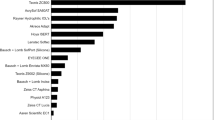Abstract
Background/Objectives
Cataract surgery with intraocular lens (IOL) implantation is one of the most commonly performed surgeries worldwide. Within the UK, publicly funded cataract surgery is remunerated by two models: (1) “block contract” (BC), which commissions organisations to deliver whole service pathways without considering specific activity items; or (2) “payment by results” (PbR), which pays a tariff price for each procedure. This study aimed to examine the association between remuneration model and the cost and types of IOL used.
Subjects/Methods
Cataract operations recorded on the Royal College of Ophthalmologists’ National Ophthalmology Database were included, with additional data collected for remuneration model from NHS England and cost of IOL from the NHS Spend Comparison Service.
Results
We included 907,052 cataract operations from 87 centres. The majority of operations were performed in PbR centres (456 198, 50.3%), followed by BC centres (240 641, 26.5%) and mixed models centres (210 213, 23.2%). The mean price of hydrophobic (n = 7) and hydrophilic IOLs (n = 5) were £45.72 and £42.86, respectively. Hydrophobic IOLs were predominantly used (650 633, 71.7%) and were significantly more commonly used in centres remunerated by BC (96.5% vs. 3.5%) than those by PbR (65.7% vs. 34.3%) when compared to hydrophilic IOLs (p < 0.001).
Conclusions
This study demonstrated that the IOL choice may be perversely incentivised by the IOL cost and remuneration model. Although hydrophobic IOLs are more expensive at the point of surgery, their potential longer-term cost-effectiveness due to reduced requirement for YAG capsulotomy should be considered.
This is a preview of subscription content, access via your institution
Access options
Subscribe to this journal
Receive 18 print issues and online access
$259.00 per year
only $14.39 per issue
Buy this article
- Purchase on Springer Link
- Instant access to full article PDF
Prices may be subject to local taxes which are calculated during checkout

Similar content being viewed by others
Data availability
The NHS England Spend Comparison Service (SCS) data utilised for this study is available to appropriate NHS bodies to the SCS by application, but cannot be made publicly available by those accessing it for secondary purposes. Access to the data from Royal College of Ophthalmologists’ National Ophthalmology Database cataract audit can be accessed by application from appropriate academic or clinical organisations to noa.project@rcophth.ac.uk, however, preparation of the data would require a fee to cover full costs of extracting and preparing the necessary data for the intended purpose from the National Ophthalmology Database.
References
Cicinelli MV, Buchan JC, Nicholson M, Varadaraj V, Khanna RC. Cataracts. Lancet. 2023;401:377–89.
Ting DSJ, Deshmukh R, Ting DSW, Ang M. Big data in corneal diseases and cataract: current applications and future directions. Front Big Data. 2023;6:1017420.
Chen X, Xu J, Chen X, Yao K. Cataract: advances in surgery and whether surgery remains the only treatment in future. Adv Ophthalmol Pract Res. 2021;1:100008.
Lamoureux EL, Fenwick E, Pesudovs K, Tan D. The impact of cataract surgery on quality of life. Curr Opin Ophthalmol. 2011;22:19–27.
Muralikrishnan R, Venkatesh R, Prajna NV, Frick KD. Economic cost of cataract surgery procedures in an established eye care centre in Southern India. Ophthalmic Epidemiol. 2004;11:369–80.
Srinivasan S, Ting DS, Lyall DA. Implantation of a customized toric intraocular lens for correction of post-keratoplasty astigmatism. Eye. 2013;27:531–7.
Erie JC. Rising cataract surgery rates: demand and supply. Ophthalmology. 2014;121:2–4.
Salerno LC, Tiveron MC Jr, Alió JL. Multifocal intraocular lenses: types, outcomes, complications and how to solve them. Taiwan J Ophthalmol. 2017;7:179–84.
Ting DSJ, Rees J, Ng JY, Allen D, Steel DHW. Effect of high-vacuum setting on phacoemulsification efficiency. J Cataract Refract Surg. 2017;43:1135–9.
Day AC, Burr JM, Bennett K, Bunce C, Doré CJ, Rubin GS, et al. Femtosecond laser-assisted cataract surgery versus phacoemulsification cataract surgery (FACT): a randomized noninferiority trial. Ophthalmology. 2020;127:1012–9.
Luo C, Wang H, Chen X, Xu J, Yin H, Yao K. Recent advances of intraocular lens materials and surface modification in cataract surgery. Front Bioeng Biotechnol. 2022;10:913383.
Donachie PHJ, Barnes BL, Olaitan M, Sparrow JM, Buchan JC. The Royal College of Ophthalmologists’ National Ophthalmology Database study of cataract surgery: Report 9, Risk factors for posterior capsule opacification. Eye. 2023;37:1633–9.
Zhao Y, Yang K, Li J, Huang Y, Zhu S. Comparison of hydrophobic and hydrophilic intraocular lens in preventing posterior capsule opacification after cataract surgery: an updated meta-analysis. Medicine. 2017;96:e8301.
Dixon J. Payment by results-new financial flows in the NHS. BMJ. 2004;328:969–70.
Berdahl J, Bala C, Dhariwal M, Rathi H, Gupta R. Cost-benefit analysis of a trifocal intraocular lens versus a monofocal intraocular lens from the patient’s perspective in the United States. PLoS ONE. 2022;17:e0277093.
Nanavaty MA, Spalton DJ, Boyce J, Brain A, Marshall J. Edge profile of commercially available square-edged intraocular lenses. J Cataract Refract Surg. 2008;34:677–86.
Nanavaty MA, Zukaite I, Salvage J. Edge profile of commercially available square-edged intraocular lenses: Part 2. J Cataract Refract Surg. 2019;45:847–53.
Ursell PG, Dhariwal M, Majirska K, Ender F, Kalson-Ray S, Venerus A, et al. Three-year incidence of Nd:YAG capsulotomy and posterior capsule opacification and its relationship to monofocal acrylic IOL biomaterial: a UK Real World Evidence study. Eye. 2018;32:1579–89.
Ursell PG, Dhariwal M, O'Boyle D, Khan J, Venerus A. 5 year incidence of YAG capsulotomy and PCO after cataract surgery with single-piece monofocal intraocular lenses: a real-world evidence study of 20,763 eyes. Eye. 2020;34:960–8.
Giers BC, Tandogan T, Auffarth GU, Choi CY, Auerbach FN, Sel S, et al. Hydrophilic intraocular lens opacification after posterior lamellar keratoplasty - a material analysis with special reference to optical quality assessment. BMC Ophthalmol. 2017;17:150.
Ng JY, Ting DSJ, Thomas S, Auffarth GU, Merz P. Opacification of hydrophilic acrylic intraocular lens following vitreoretinal surgery: a clinicopathological report. Can J Ophthalmol. 2021;56:e9–e11.
Grzybowski A, Zemaitiene R, Markeviciute A, Tuuminen R. Should we abandon hydrophilic intraocular lenses? Am J Ophthalmol. 2022;237:139–45.
Acknowledgements
It is with gratitude that we remember our friend and colleague Robert Johnston, who sadly died in September 2016. Without his inspirational vision, determination and career long commitment to quality improvement in ophthalmology this work would not have been possible. We acknowledge the support of the hospitals that participated in this National Ophthalmology Database Audit study and thank our medical and non-medical colleagues for the considerable time and effort devoted to data collection. The 87 centres with data in this analysis are listed in alphabetical order below separated into NHS Trusts and ISTC sites.
NHS Trusts:
Barking, Havering and Redbridge University Hospitals NHS Trust; Barts Health NHS Trust; Bolton NHS Foundation Trust; Bradford Teaching Hospitals NHS Foundation Trust; Calderdale and Huddersfield NHS Foundation Trust; Chesterfield Royal Hospital NHS Foundation Trust; County Durham and Darlington NHS Foundation Trust; East Kent Hospitals University NHS Foundation Trust; East Suffolk and North Essex NHS Foundation Trust; East Sussex Healthcare NHS Trust; Epsom and St Helier University Hospitals NHS Trust; Frimley Health NHS Foundation Trust; Gloucestershire Hospitals NHS Foundation Trust; Great Western Hospitals NHS Foundation Trust; Hampshire Hospitals NHS Foundation Trust; Harrogate and District NHS Foundation Trust; Imperial College Healthcare NHS Trust; Isle of Wight NHS Trust; James Paget University Hospitals NHS Foundation Trust; King’s College Hospital NHS Foundation Trust; Kingston Hospital NHS Foundation Trust; Leeds Teaching Hospitals NHS Trust; Liverpool University Hospitals NHS Foundation Trust; Manchester University NHS Foundation Trust; Mid Cheshire Hospitals NHS Foundation Trust; Mid and South Essex NHS Foundation Trust; Moorfields Eye Hospital NHS Foundation Trust*; Norfolk and Norwich University Hospitals NHS Foundation Trust; North Cumbria Integrated Care NHS Foundation Trust; North Middlesex University Hospital NHS Trust; North West Anglia NHS Foundation Trust; Nottingham University Hospitals NHS Trust; Oxford University Hospitals NHS Foundation Trust; Portsmouth Hospitals University NHS Trust; Royal Berkshire NHS Foundation Trust; Royal Cornwall Hospitals NHS Trust; Royal Free London NHS Foundation Trust; Royal United Hospitals Bath NHS Foundation Trust; Salisbury NHS Foundation Trust; Sandwell and West Birmingham Hospitals NHS Trust; Sheffield Teaching Hospitals NHS Foundation Trust; Sherwood Forest Hospitals NHS Foundation Trust; South Tees Hospitals NHS Foundation Trust; South Warwickshire University NHS Foundation Trust; Southport and Ormskirk Hospital NHS Trust; St Helens and Knowsley Teaching Hospitals NHS Trust; Surrey and Sussex Healthcare NHS Trust; The Hillingdon Hospitals NHS Foundation Trust; The Mid Yorkshire Hospitals NHS Trust; The Newcastle upon Tyne Hospitals NHS Foundation Trust; The Princess Alexandra Hospital NHS Trust; The Shrewsbury and Telford Hospital NHS Trust; Torbay and South Devon NHS Foundation Trust; United Lincolnshire Hospitals NHS Trust; University Hospital Southampton NHS Foundation Trust; University Hospitals Birmingham NHS Foundation Trust; University Hospitals Bristol and Weston NHS Foundation Trust; University Hospitals Coventry and Warwickshire NHS Trust; University Hospitals Dorset NHS Foundation Trust; University Hospitals Plymouth NHS Trust; Warrington and Halton Teaching Hospitals NHS Foundation Trust; Wirral University Teaching Hospital NHS Foundation Trust; Yeovil District Hospital NHS Foundation Trust;
ISTC sites:
St. Stephens Gate Medical Practice;
The following sites from Optegra Eye Health Care: Birmingham Eye Hospital; Central London Eye Hospital; Hampshire Eye Hospital; Manchester Eye Hospital; North London Eye Hospital; Surrey Eye Hospital; Yorkshire Eye Hospital;
The following sites from Practice Plus Group: Emersons Green; Ilford; Plymouth; Shepton Mallet; Southampton; Rochdale; Devizes; Gillingham; St. Mary’s Portsmouth
The following sites from SpaMedica: Birkenhead; Bolton; Liverpool; Manchester; Newton-le-Willows; Sheffield; Wakefield;
*Includes data from Bedford Hospital within Bedfordshire Hospitals NHS Foundation Trust and Croydon Health Services NHS Trust as the ophthalmology services in these places are part of Moorfields Eye Hospital NHS Foundation Trust.
Funding
This analysis was funded by an unconditional grant from Alcon (Geneva, Switzerland) in support of the Royal College of Ophthalmologists’ National Ophthalmology Database cataract audit. The funders did not have any editorial oversight, right of veto or academic input into the analysis or write up of this work. The National Cataract Audit is currently funded through participation fees from centres as well as unrestricted financial contributions from Bausch + Lomb and Alcon.
Author information
Authors and Affiliations
Contributions
All authors participated in initial discussions regarding study design and definitions. All authors reviewed initial drafts and approved final manuscript. DSJT and PHJD prepared the first draft (PHJD – “Methods” and “Results”; DSJT – “Introduction” and “Discussion”).
Corresponding author
Ethics declarations
Competing interests
The authors declare no competing interests.
Additional information
Publisher’s note Springer Nature remains neutral with regard to jurisdictional claims in published maps and institutional affiliations.
Rights and permissions
Springer Nature or its licensor (e.g. a society or other partner) holds exclusive rights to this article under a publishing agreement with the author(s) or other rightsholder(s); author self-archiving of the accepted manuscript version of this article is solely governed by the terms of such publishing agreement and applicable law.
About this article
Cite this article
Ting, D.S.J., Tatham, A.J., Donachie, P.H.J. et al. The Royal College of Ophthalmologists’ National Ophthalmology Database study of cataract surgery: report 16, influence of remuneration model on choice of intraocular lens in the UK. Eye 37, 3854–3860 (2023). https://doi.org/10.1038/s41433-023-02665-y
Received:
Revised:
Accepted:
Published:
Issue Date:
DOI: https://doi.org/10.1038/s41433-023-02665-y



